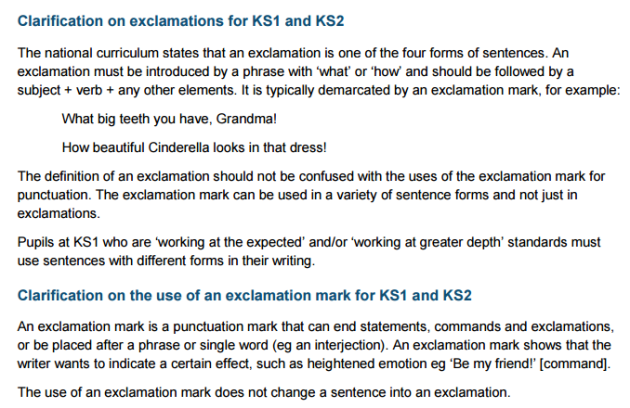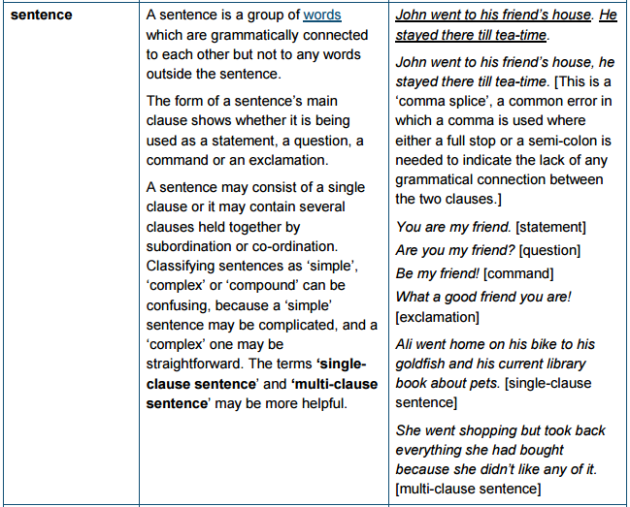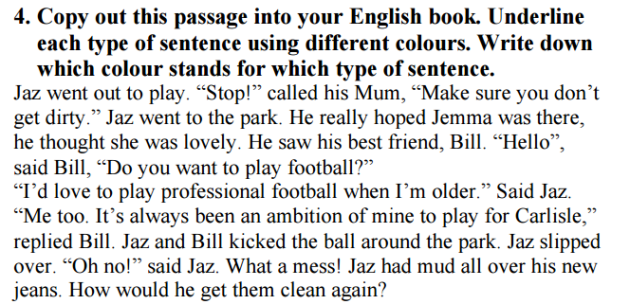Have I got precision for you!
March 11, 2016 6 Comments
I know I’ve got a bit of a reputation for pedantry, especially when it comes to DfE curriculum documents. I promise you, I don’t scour them all looking for mistakes. That would be petty. But when they’re physics bloopers or causing a ruckus, then I like to look into things a bit more.
What follows isn’t a judgement on whether the DfE are right or wrong about exclamations, only that I think their instructions and definitions lack clarity and precision, and that this topic is likely to be very confusing for 10/11 year olds (and under).
Firstly, I fully accept that the exclamation debacle is not about whether students are only allowed to use exclamation marks after exclamations that begin with what or how. It is about the definition of an exclamation and in an attempt to calm the waters, the DfE have sent out this clarification:

Instructions in the clarification document
“The use of an exclamation mark does not change a sentence into an exclamation”. Of course it doesn’t! No one said it does (though some have had a joke about banning exclamation marks).
Let’s read the top line together shall we: The national curriculum states that an exclamation is one of the four forms of sentences.
Yes it does, here it is:

And the rest of the relevant detail (they discuss exclamation marks a lot too).

There’s the example: What a good friend you are! [exclamation]
So what’s the problem? Well, one example is rather vague isn’t it? And looking online for resources that schools use throws up some anomalies. Let’s ignore English schools using American English resources (a troublesome situation perhaps).
Here’s the second resource in a google search for sentence types exclamation
http://www.primaryresources.co.uk/english/pdfs/sentence2.pdf
And a task from it:

How do we know which are the exclamations?
In a SPAG test the only correct answer is What a mess! [EDIT more on this later]
But depending on your definition then Stop! and Oh no! might be classed as exclamations:
an abrupt, emphatic, or excited cry or utterance; interjection; ejaculation
http://www.collinsdictionary.com/dictionary/english/exclamation
An exclamation (also called an interjection) is a word or phrase that expresses strong emotion, such as surprise, pleasure, or anger. Exclamations often stand on their own, and in writing they are usually followed by an exclamation mark rather than a full stop:
How wonderful!
Ow! That hurt!
Exclamations are also used to express greetings or congratulations:
Hello!
Well done, lads!
http://www.oxforddictionaries.com/words/exclamations
The DfE don’t really mean exclamation when they say exclamation. They mean exclamation clause.
The only clear definition I’ve found about exclamation clauses comes from English Grammar Today via the Cambridge dictionary website:
We use exclamations to express surprise or shock or a strong emotion about something. The type of phrase or clause associated with exclamations is called exclamative.
We usually form exclamatives with what or how. In writing, we usually put an exclamation mark (!) at the end of the exclamative:
What an amazing car!
How I love the summer holidays!
http://dictionary.cambridge.org/grammar/british-grammar/exclamations
The suggestion here is that there are different forms of exclamations with certain exclamation clauses (exclamatives). But they don’t just include what and how forms as shown further down on that page.
There are interrogative exclamatives that appear like questions but aren’t: Have I got news for you! which is functionally the same as I’ve got news for you! but the I and the have are inverted. It’s not a question, you wouldn’t answer yes or no (it’s not even a rhetorical one). It’s an exclamatory statement (and a commonly used one at that).
So here’s the thing: the document that test developers are to use is very specific about what is and isn’t allowed for the test.

Instructions to SPAG test developers.
Those weasel words are such a problem (for me as a parent): For the purposes of the test.
Everywhere there are resources children are using to learn to read and write from. And there are exclamations throughout them. I’ve just been through my daughter’s reading books. They’re everywhere. Some are interjections, some are what or how sentences. Some are imperative.
It’s confusing, and as my series of tweets from earlier this evening suggested – the DfE would have done well to define exclamation separately from an exclamative clause which is what they’re testing in the SPAG test.
Have I got pedantry for you! If only the DfE had used the term exclamative as the clause to begin with what or how. https://t.co/bH3X590g2n
— Alex Weatherall (@A_Weatherall) March 11, 2016
(there are more below that one)
Anyway I leave you with an exclamation; how would you categorise it?
“Boy, do I hate being right all the time!”
Dr. Malcolm in Jurassic Park
*Thanks @DiLeed for the retitle.
EDIT – Martin Galway has added a further twist in the comments below – I will summarise here:
I spotted something as I went to sleep last night, that was still bothering me this morning, and then Martin wrote to me on twitter asking if I minded him adding a comment – I said of course. What a comment [he wrote]!
You see, the clarification document at the top of the page in trying to make things better, adds another constraint:

Wait a minute!
Let’s recap the new rules (from Martin’s comment below). Perhaps a check list would help the students:
- Phrase begins with What / How?
- Does not take the form of a question?
- Subject + verb?
- Exclamation mark?
OK so lets look at the examples we’ve got [as pointed out by Martin]:
What a mess! (from the online teacher resource I found – and I thought passed the SPAG test)
This passes 1,2 and 4 but not 3 which was added in the clarification document! <- 10 points from Gryffindor.
What a lovely day! (example from the Test Specification document from the DfE!)
This passes 1,2 and 4 as well. Their own example doesn’t pass the requirements in the clarification document! <- 50 points from Slytherin 😉
How exciting! (2nd example from the Test Specification document from the DfE!)
This passes 1, 2, and 4 – but this has neither a subject nor a verb. Again the example they have given the test developments doesn’t pass the requirements in the clarification document! <- 200 points from Slytherin
Boy, do I hate being right all the time!
This doesn’t pass 1 or 2, but it has a subject, a verb and an exclamation mark 🙂 <-20 points from Gryffindor
So let me spell this out for you: the examples for the test developers contradict the clarification document!
From Martin below:
The fact that the frameworks continue to linger online with examples that are not creditworthy strengthens your point. Contradictory materials have led to confusion, and have led to all sorts of inference going on – some inferefences complete/some not. For my part, until the writing exemplars came out, my colleagues and I thought this would only appear in the test. The framework said:”For the puprose of the test.” So it seemed a reasonable deduction. Now that it is required in teacher assessment of writing for KS1, somehow these constructions will need to appear in the range of evidence.
What a total and utter stupid mess [this is]! <- 100 points to Gryffindor 🙂
HI Alex
First up – thank you for this blog. Some others on twitter, and my colleagues for sure, will attest to the fact that I have been challenging this issue for close to a year now. Initially on the basis of the degree to which it deserves a place in KS1 assessment / as a statutory element when we know more than ever, how precious the learning achieved in early years/KS1 truly is. But like you, I won’t get into the right or wrongs. I have been told by many people over the past year that i have “made my point.” They mean, “shut up about it.” They’re polite.
Next – apologies – there will be digressions – this has come to be a minor obsession for me.
So I told you there’s a twist – it’s been a twisty year – and it is captured on this page. Go back to the most recent clarification and it’s there: An exclamation must be introduced by a phrase with “what” or “how” and should be followed by a subject + verb and any other elements.”
It’s that subject/verb bit, I wanted to flag so that everything is in place here.
(I was glad to see this blog in the same way that i was when the issue exploded and gained a massive profile. That was short-lived when silly season kicked in – Shakespeare would fail/exclamation marks banned – unintentionally causing more confusion and panic. Is it sad that it kind of broke my heart a bit? I thought we might be on the cusp of a successful bid to discuss this rationally, logically and most of all pragmatically).
Anyway – subject/verb. As you show, in the glossary for the curriculum they meet the requirements of their own terms of reference.
What a good friend you are!
1. Phrase beginning with What? Tick
2. (Implied requirement – I think this was from the exemplars; picked it up somewhere): Does not take the form of a question? Tick.
3. Subject + verb bit bringing up the linguistic rear, pantomime horse stylee? Tick.
4. All important exclamation mark to seal the deal? Tick. Boom! Mission accomplished.
Now consider the test framework examples and – understandably given their model – your own:
What a mess! (Yours)
What a lovely day! (test framework)
How exciting! (test framework)
Run them through our success criteria above and they fall down on point 3. Where’s your subject/verb young man. Of course the easy-going (and they often seem to be) linguist will say “Chill out chaps – the subject verb is clearly implied – it’s ellision – move on.” I like to think linguists are chilled out because they cherish the flexibility of language – its lack of stasis. You have to go with the flow or you’ll end up Angry of Enfield most times you connect online.
The fact that the frameworks continue to linger online with examples that are not creditworthy strengthens your point. Contradictory materials have led to confusion, and have led to all sorts of inference going on – some inferefences complete/some not. For my part, until the writing exemplars came out, my colleagues and I thought this would only appear in the test. The framework said:”For the puprose of the test.” So it seemed a reasonable deduction. Now that it is required in teacher assessment of writing for KS1, somehow these constructions will need to appear in the range of evidence.
Basically we have ended up with a bit of a linguistic minefield for infant children. I’ll let others draw their conclusions about how they feel about that.
That said, in all of my encounters with y2 teachers in recent weeks, they are doing that thing thatgood teachers do: making this work in the best way possible for the children that I teach/know/care about. I’m not sayingthey should have to – but given the circumstances, I applaud them.
For the sake of clarity/those losing the will to live, I’ll just end on a few points based on HOW THINGS CURRENTLY STAND.
if you need this to be credited – if you don’t happen to havce it already in place – make sure:
1. it starts with What or How
2. is not formed as a question
3 has a subject verb
and has an exclamation mark at the end.
Do not drill and kill this for the test – as you rightly say, it can cause confusion with early reading if we are too narrow about this. That’s the last thing we want. Early reading involves so much – the teaching of the reading of punctuation as well as the act of decoding graphemes. And not eating the book. And knowing it carries meaning . And loving it. And getting excited for the next book. And loving (not fearing) language – even its complexities. etc.
Grammar is all about the art of making meaning. Worth keeping that in mind at all times.
Now feel free to tell me, “you’ve made your point!”
Apologies for the ridiculously epic nature of the comment.
Indeed.
Apologies, too, for the typos. Phone typing not my bag.
Thank you, too, for this blog post. Of course we are going through a pedantic period in our grammar expectations. We would be, because they’re trying to prescribe what is essentially descriptive! It’s amusing for me, as an erstwhile pedant, myself! It’s also sad and soul-destroying.
Correction to my reference to elision : meant ellipsis. Note to self: less haste…
Hey, you’re not writing a curriculum document.